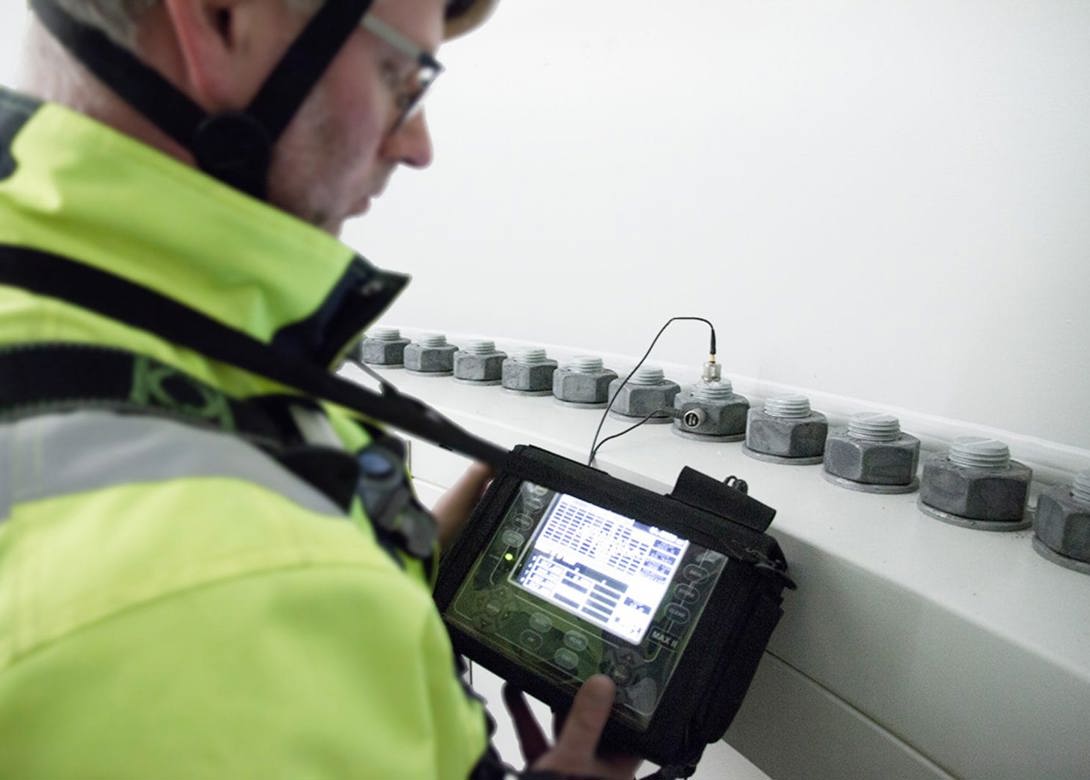
Wind turbines typically contain more than 6,000 bolts. The inspection of the larger critical bolts is required at regular intervals – these inspections are time consuming and therefore expensive, and often the results obtained can vary, depending on the actual inspection method.
R&D AS, an engineering company headquartered in Denmark supplies test systems and consultancy for the wind energy sector, including the Bolt-Check system, a bolt tension measuring tool that provides an optimal balance between user friendliness, accuracy, reliability and cost.
Every bolted joint in a wind turbine is set to the appropriate joint loading tension during the assembly process, but it then requires regular in-service tension inspections. This is because a bolt can lose tension over time due to the forces and vibrations they are subjected to, a situation that, at worst, could result in the failure of the entire turbine.
This regular inspection of the bolts is carried out in line with the manufacturer’s maintenance schedule to ensure safe and optimal operation. This is usually accomplished using torque or tension tools, but recently new methods have been developed using ultrasound, load sensors or mechanical indicators.
Designed to be used on standard bolts, Bolt-Check offers wind turbine manufacturers and service companies a series of benefits normally only available at much higher prices. Increasingly, bolt-tension tools use electronic sensing methods like ultrasound. The operating principle is based on using sound waves to measure the length of the bolt, which lengthens during tensioning. The tension can then be calculated. Mechanical methods for measuring bolt tension, on the other hand, typically use a calliper that mechanically measures the change in length.
One way of monitoring a bolt’s tension while it is in service is by using specially designed bolts with embedded tension indicators. These bolts will indicate a loss of tension, but the problem is they have a substantial initial investment cost.
The ‘Bolt-Check Advanced’, a tool developed by R&D to measure the tension of installed bolts, offers a cost-effective solution to easily determine the actual clamping force in bolts. This tool does not require thousands of bolts to be loosened and then retensioned in order to measure the loading on the joints. Instead, it uses its proprietary method based on combining an ultrasonic length measurement with a mechanical measurement. This is done using a custom tool featuring a micro gauge and an ultrasonic sensor which can be used to check any standard bolt.
Using R&D’s patented method involving both mechanical and ultrasonic measurements along with the uniformity of properties within the different bolt batches, it is possible for Bolt-Check to achieve an accuracy of approximately 10%. There is also a huge time saving advantage as the system allows hundreds of bolts to be checked in just a few hours.

Having spent a decade in the fastener industry experiencing every facet – from steel mills, fastener manufacturers, wholesalers, distributors, as well as machinery builders and plating + coating companies, Claire has developed an in-depth knowledge of all things fasteners.
Alongside visiting numerous companies, exhibitions and conferences around the world, Claire has also interviewed high profile figures – focusing on key topics impacting the sector and making sure readers stay up to date with the latest developments within the industry.





